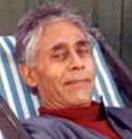
Shiva Sutras 3.4 & 3.5 – The Means to Transcend Limited Perception
God is everything and everyone, including you. If you feel now and again that I
am repeating the same idea - that is because there is only this one idea. The
first Shiva Sutra 1.1 says that God consciousness is “the reality of everything.
[SLJ]” The difficultly comes in getting that understanding beyond the intellect
and into our very being, so that the ever expanding nectar sweetness of the God
within is felt every moment, in our every thought and act.
The third section of the Shiva Sutras offers the aspirant
practical means (upayas) to achieve
God consciousness. Ways of maintaining awareness in breathing, reciting mantras,
and other disciplines are explained. This is called
anavopayah, which is said to be the
‘inferior’ means because it utilizes the external, literally the five elements -
earth, water, fire, air, and ether; and requires more effort.
The Vijnana Bhairava Tantra is another Shaivite text that will help you on your
way Home. It gives the aspirant 112 ways to achieve God consciousness. The most
accurate version of Swami Lakshmanjoo’s teachings on this text is the one
recorded and transcribed by John Hughes, the Universal Shaiva Foundation.
Swami Lakshmanjoo describes these 112 ways as giving sugar to a child with
medicine. He says that no one can take the “medicine where you have to do
nothing.” By this he means that in fact there is nothing to be done – we are all
already the Oneness, what he terms God consciousness, Parabhairava. However to
remove the Veils of Maya we have placed on our own consciousness, most of us
must take the medicine by these means, practices and disciplines, as support to
achieve our real nature. [SLJ - Vijnana Bhairava Tantra]
I will not describe the details of many of these means, especially breath
techniques. I feel it is best for you to get them personally from Swami
Lakshmanjoo’s writing. He says that these kinds of meditations are found in
every Tantra text of Shaivism. I am not qualified to instruct you in these
exercises. I would not know what might suit an individual, as we are all very
different and require the kind of means suited to our particular personal
proclivities.
Shiva Sutra 3.4
Sarire samharah kalanam
The mind wanders ceaselessly. Anyone who has ever tried to meditate or even sit
in silence for a time has discovered what a wild horse monster the mind can be.
In the Bhagavad Gita VI.33 & 34, Arjuna doubts his ability to follow Krishna’s
teachings because he knows how difficult controlling the mind can be. Arjuna
does not see how an evenness of mind can be achieved permanently, because the
mind is unstable and wandering, harassing, unyielding, and as difficult to
control as the wind.
Krishna agrees with Arjuna that the mind is arduous to control, but reassures
him that such equilibrium is possible through means - upayas. Later in Chapter
XVIII.37, Krishna tells his friend that in the beginning our efforts may feel
like poison, but turn to nectar as we move beyond the clutter and impatience of
our chaotic thoughts and find peace, tranquility, and serenity. The implication
is that in the beginning this is not so easy for most of us. But the effort
brings a reward greater than all the gold, success, and power in this external
temporal world.
Here in the Shiva Sutras we are introduced to the idea of a means to God
consciousness by taking your thoughts through specific sequences in order to
discipline the mind, thereby purifying your thoughts from delusion. These
methods will “curtail this limitation of being. [SLJ]”

Our hologram is divided into five circles or enclosures, from gross to subtle.
We are told to use our imagination to move from the gross manifestation to the
subtle. We do this by putting the effect into the cause, moving from one circle
of manifestation to the next, which lies within it – like layers of an onion -
until we reach the cause of all the layers and find there is only One.
Swami Lakshmanjoo: “…take your attention from the gross orbit to the subtle
orbit and then to the subtlest orbit, absorbing one into another.”
In the Vijnana Bhairava Tantra, verse 56, there is a
similar instruction. “Just take the gross formation of the world and make it
enter in it subtle formation of the world through imagination…take that subtle
formation of the objective world in its most subtle formation…by making the
journey successively from gross (sthula)
to subtle (sukshma), and from
subtle to subtlest (para)…he
transcends the state of mind, he becomes un-minded. That is his Samadhi. [SLJ]”
The same effect is achieved by reading the Kashmir Shaivite Sanskrit texts. They
all say essentially the same thing – everyone and everything is God! But by
reading and rereading these timeless words of wisdom your consciousness will
finally get the message that differentiated perception is the Illusion (Maya)
you can transcend. Your consciousness will be elevated and come into resonance
with the eternal Truth within you.
For those who have active noisy minds or are intellectually inclined, these
methods are useful. They serve to lead us into right thinking about our universe
and who we are in it. There are further instructional details in this sutra
which you will want to access for yourself.
***
The achievements of those who have become un-minded are
extolled by Krishna in Chapter Twelve of the Bhagavad Gita. The ones who have
reached the imperishable (aksharam),
that which is beyond definition
(anirdeshyam), the unmanifest unseen
(avyaktam), the all pervading
(sarvatragam), unimaginable and inconceivable
(acintyam), the unchanging
(kutastham), the immovable
(acalam), the eternal
(dhruvam); who have controlled all
the senses and become even minded, rejoicing in the welfare of all beings – they
attain God consciousness.
Krishna then says that attaching the mind to the
Unmanifest is difficult (duhkham).
However our innate simple human feelings of love can also be a means to reach
God. By becoming devoted to God in our Hearts, we learn that the God within us
is everywhere and soon our consciousness enters into that which we always are –
the One.
The trick is to always think of God. The old Indian adage is ‘God is the pot!’
meaning everything we see, touch or hear is God. When you are washing the dishes
think of the plates and water as God. When a friend is angry with you, see them
as God, perhaps a bit lost and confused in that moment – but God nonetheless.
See the light of the soul, which is also your soul, in their eye. See God in
every eye.
Soon the subtlest feelings of Love will fill your Heart and expand that
delightful nectar into every corner of your Being. These subtle feelings are
beyond all others, beyond the five senses and the intellect, beyond words to
describe. Krishna tells Arjuna, “Henceforth you shall dwell in Me” [BhG XII.8],
in God consciousness, in Parabhairava.
Shiva Sutra 3.5
Nadisamhara-bhutajaya-bhutakaivalya
In this sutra, Swami Lakshmanjoo explains a breathing technique that removes our
awareness from the gross elements and diverts our attention away from the five
senses. I recommend the recordings of these teachings in the Shiva Sutras made
by John Hughes years ago in Kashmir. You will know what is useful to you.
In the beginning of our journey Home, most of us need to practice disciplines
that will lead us into more the subtle realms. You will not always need these
‘inferior’ means and someday may find that the God within you has opened your
Heart to the ultimate Reality that you are and always have been the Oneness.
These inferior means of concentration and realization often lead to the other
two. Where one ends, another may begin.
You will not need to meditate or practice breathing or read books or anything,
but simply remain in God consciousness. Swami Lakshmanjoo says that when his
disciples really understand what he is teaching them, they won’t want to listen
to him anymore! He has a wonderful sense of humor about all this. I sometimes
feel Swami Lakshmanjoo looked at people with a gently amused sense of wonder at
the endless array of predicaments God gets Itself into. But that is just my
intuition.
 Swami
Lakshmanjoo
Swami
Lakshmanjoo
***
Vijnana Bhairava, The Manual for Self Realization, Revealed by Swami
Lakshmanjoo, edited by John Hughes; Universal Shaiva Fellowship, 2007.
The Bhagavad Gita, translated by Winthrop Sargeant; State University of New York
Press, 1994.
|
|